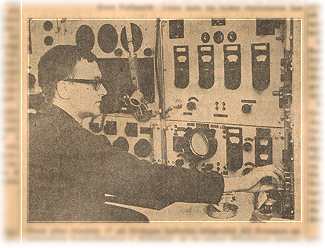 Saturday
11 August 1962
Saturday
11 August 1962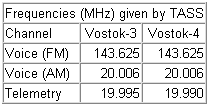 After
the successful flight of Gherman Titov in August 1961, most observers
expected
the next Soviet manned spaceflight to be flown soon. Howeveer, the
Korolev
design bureau concentrated on getting the military spy satellite
version
of Vostok - Zenit - to work. However, when John Glenn flew in February
1962 the Soviet leadership suddenly asked Korolev to launch the next
space
spectacular promptly. But there were problems with Zenit and only one
operational
launch pad at Baikonur for this type of launch vehicle. This delayed
the
first group flight until August. The notion of a group flight had been
advanced in the months after Vostok-2. Initially the idea was to fly
three
spacecraft, but soon a consensus was reached to fly two vehicles.
The final decision on the flight duration was taken as late as 18 July
1962 when the two flights were aimed at lasting "up to three days".
That
the flights lasted four days was due to a decision taken during the
flight
by Khruschov himself. (8)
After
the successful flight of Gherman Titov in August 1961, most observers
expected
the next Soviet manned spaceflight to be flown soon. Howeveer, the
Korolev
design bureau concentrated on getting the military spy satellite
version
of Vostok - Zenit - to work. However, when John Glenn flew in February
1962 the Soviet leadership suddenly asked Korolev to launch the next
space
spectacular promptly. But there were problems with Zenit and only one
operational
launch pad at Baikonur for this type of launch vehicle. This delayed
the
first group flight until August. The notion of a group flight had been
advanced in the months after Vostok-2. Initially the idea was to fly
three
spacecraft, but soon a consensus was reached to fly two vehicles.
The final decision on the flight duration was taken as late as 18 July
1962 when the two flights were aimed at lasting "up to three days".
That
the flights lasted four days was due to a decision taken during the
flight
by Khruschov himself. (8)
Friday 10 August 1962
During the evening of 10 Aug 1962 rumors started among journalists in Moscow that a space spectacular was imminent. Soviet journalists had been told to watch the radio news closely in the days to follow. A much longer flight than that of Vostok-2 was one possibility mentioned, but also the launch of two cosmonauts. (9)
 Saturday
11 August 1962
Saturday
11 August 1962In Sweden, the Telecommunications Administration monitoring station at Enkoping near Stockholm picked up Vostok-3 (1). Beacon signals on 19.995 MHz were picked up by operator Alf Svensson (see picture on the right) at 1303 and 1432 UT. At 1606-1608.30 UT the following conversation was picked up on 20.006 MHz by the same station:
"....in eight
minutes
the fifth revolution will be completed... Vesna 1, ya Sokol (Eagle) I
give
you some data; the time is now 1908...one and one,, and and
two..temperature
203, I feel fine..."
More beacon signals were picked up on 19.995 MHz at 1734 and 1905-1913 UT.
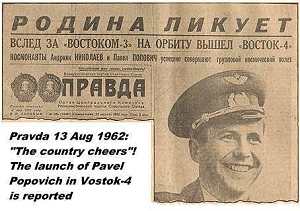 Sunday
12 August 1962
Sunday
12 August 1962Monday 13 August 1962
Beacon signals from the spacecraft were picked up by Telecommunications Administration monitoring station at Enkoping at 0738, 1037, 1207,1338 UT. Some voice was heard at 1509 UT followed at more beacon signals in the evening; on 19.995 MHz at 1939 UT and on 19.990 MHz at 1942 UT. The Japanese monitoring station at Chiba reported that they had heard ground stations order the cosmonauts to prepare for descent (2), but Moscow denied all rumours of an imminent landing.
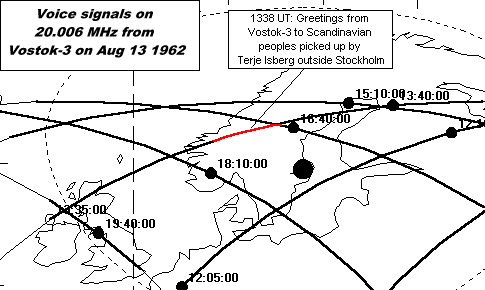 A
greeting
to the Scandinavian peoples was sent from Vostok-3 at 1338 UT (3)
and picked up by
Terje Isberg
in Danderyd outside Stockholm (6). the
message
read: ".. From the Soviet space ship Vostok-3 I send a
greeting
and the best wishes to the Scandinavian peoples. Cosmonaut
Nikolayev....."
A
greeting
to the Scandinavian peoples was sent from Vostok-3 at 1338 UT (3)
and picked up by
Terje Isberg
in Danderyd outside Stockholm (6). the
message
read: ".. From the Soviet space ship Vostok-3 I send a
greeting
and the best wishes to the Scandinavian peoples. Cosmonaut
Nikolayev....."
".....Vesna 1, ya Sokol. You have made an error of five minutes at your latest time report. I have checked and the time was not 1512 Moscow Time as you said but rather 1507. Now, give me a new time. Can't you hear me? I hear you very well, Now get started with your time report. No, now you are getting it wrong again! You do not do this the right way! Now listen to me! Listen, I said! I will teach you how to do this perfectly. Correct time is 1609..1609...1609.. attention! (Vnimanie)....now (otchet)!....Vesna 1- that was a correct time report, wasn't it? That's is the way to run the show and not in the sloppy way that you did. Vesna 6 gave me correct time at 1529 and they knew how to do it. Please convey my thanks to Vesna 6. Their time report was really good.... Yes, OK, your time report is correct now, thanks ... Here on board all is well. The cabin pressure is 1 and 1, temperature 12, humidity 72, pressure in the instrument section 1 and 2, pressure in the manual system is 70 and in the automatic system: first 145, second 130. As for myself, I feel excellent. Everything is working out precisely as we planned. Cheerio (privet)..."
At 1607 UT the Vostok-4 beacon on 19.989 MHz was heard. At 1609 UT cosmonaut Nikolayev was again heard on 20.006 MHz talking to "Vesna 1":
"....Vesna 1, ya Sokol how do you read me? I will relay some instrument readings. Pressure in the catapult system is 300.. I have been in touch with Golden eagle (Berkut) at the southern point. At this moment I have no contact with Berkut...". This was the first time that Sokol mentioned the catapult!
At 1620 "Sokol" can be hard calling "Vesna 4" saying that "I am concentrating on point 20 in the flight plan". Thereafter he calls Vesna 7. Beacon signals from Vostok 4 were heard on 19.990 MHz at 1735-1800 UT.
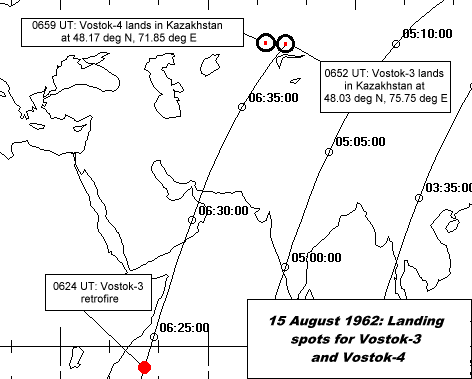 Wednesday
15 August 1962
Wednesday
15 August 1962Beacon signals on 19.995 MHz (i.e. from Vostok-3) and weak voice on 20.006 MHz appeared at 0628-0632 UT, At 0652 the word "...Three...three..." were heard in Russian and at 0715 the word "Attention" (Vnimanie)! was broadcast on this frequency.
At 0741 UT Radio Moscow announced that an important message would soon be broadcast and after intermission music radio announcer Yuri Levitan's booming voice appeared at 0748 UT (5) to announce the landing of both ships.
Andriyan Nikolayev landed in Vostok-3 at 0652 UT on 15 August 1962 at 48.03 degrees North, 75.75 degrees East. Pavel Popovich landed in Vostok-4 at 0659 UT on 15 August 1962 at 48.17 degrees North, 71.85 degrees East. The Vostok-3 retrorocket had ignited at 0624 UT and that of Vostok-4 six minutes later. (7)
It is interesting that
they
both landed on the same parallel, the 48 th. For Vostok 5 and 6 the
same
principle was used, but the landing was made on the 53 rd parallel.
Perhaps
the idea was to deploy recovery forces in an east-west pattern? Later,
during fights of the Zenit reconnaissance satellite landings were made
roughly along the 52 nd parallel (See Landing
zones for Zenit-2 missions).
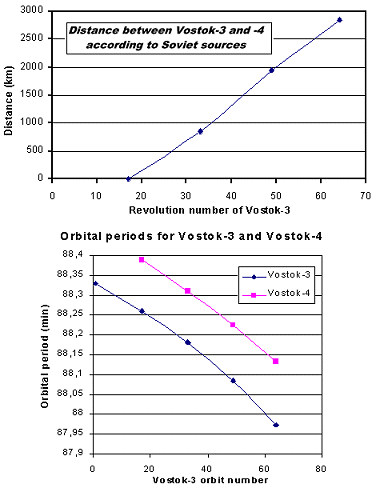
The distance between
the
spacecraft given by Soviet sources (7)
is
probably quite accurate concerning the distance between the spacecraft
days after the launch of Vostok-4. The graph on the right is entirely
consistent
with the differnce in orbital period of 0.13 minutes given by the same
source. The same source gave the initial distance between the ships as
6.5 kilometers. There is no way to check this number, but there is also
no reason to doubt it.